
Spout pouches occupy an irreplaceable part among the packages of household cleaning chemicals, and there is a high requirement for the spout pouch materials to protect the liquids in a safe situation. Compared to plastic bottles, this 2-liter spout pouch can save more space in transportation and reduce the use of plastics. Furthermore, the whole body can be printed with beautiful designs and logos, for better branding.
As a well-known flexible converter located in Qingdao, China, we are making the best use of the packaging film materials in the market, listed below.
- fossil chemical polymer films
- Aluminum foil metal sheet
- vacuum metalized film materials
- Ceramic film substrates
- plant-based biopolymer materials
- biodegradable film materials
- compostable substrate films
- Fully recyclable substrate films
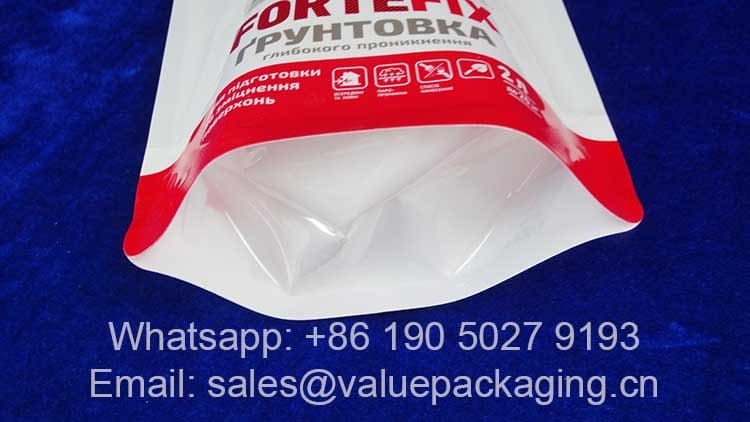
We are devoted to creating story-telling standup spout doypack bags for cleaning chemicals that increase product sales and establish a good brand image.
In this post, we will analyze the exact foil materials of this 2 litre spout pouch for household cleaning liquids, hoping it could serve as a reference for your products.
Ok, let’s get into the details.
Packaging Foil Materials
To protect 2 liters of household cleaning chemicals in the package, the foil materials will have to be reinforced with robust polymer films. As you can learn from the graphic below, the foil structure is set as PET12/NY15/LDPE, which is a strong material for most liquid products.

It is made of triplex layers, with the outside PET film 12 microns working as the print substrate film, the BOPA film 15 microns working as the middle supportive and barrier layer, and finally, the LDPE film working as the inner sealing layer. The thickness of the LDPE film should be adjusted to suit the requirements of 2000ml cleaning chemicals.
Next, let’s get a deeper understanding of each substrate film material.
PET12 Film
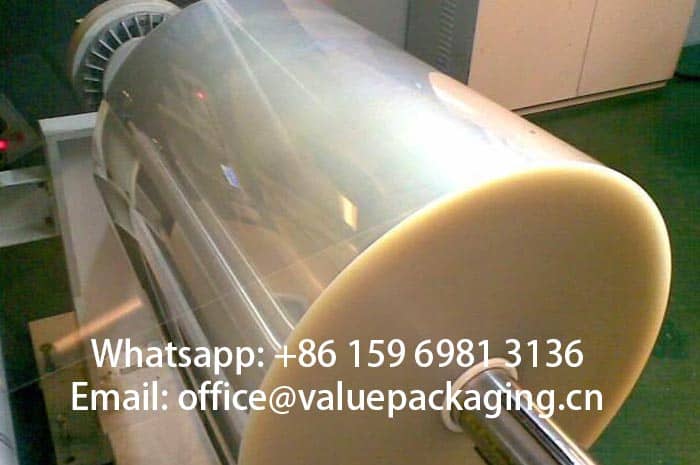
PET film, or polyethylene terephthalate film, is a thermoplastic polymer resin that is a type of plastic film. It is a versatile material with many uses due to its physical, mechanical, optical, thermal, electrical, and chemical properties. PET film is available in various thicknesses, widths, and transparencies.
BOPA
BOPA stands for Biaxially Oriented Polyamide, which is also known as biaxially oriented nylon (short as NY) film. It’s a versatile and flexible material that’s made by biaxially stretching polyamide resins using a flat cast die process, the three-layer co-extrusion method, and the two-step tenter frame orientation.
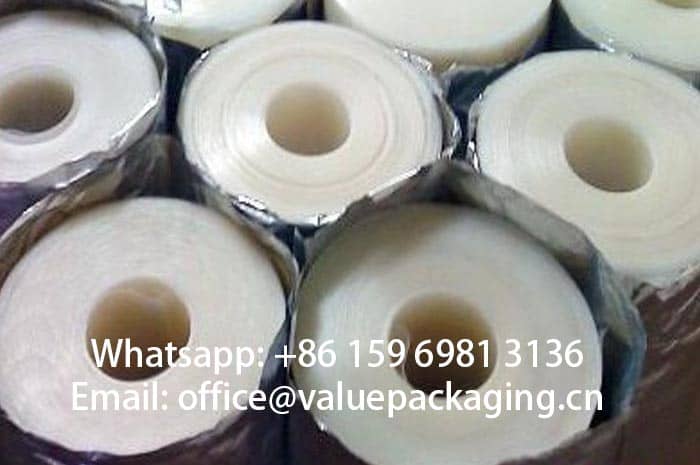
For this kind of large-capacity product, and to maintain a good standing display, PA film is a suitable choice. It will make the packaging more rigid and enhance the standing appearance.
LDPE Film
LDPE film is short for low-density polyethylene film, which is the most used inner sealing layer for standing spicy chili sauce bags. LDPE is also lightweight, easy to fabricate, and has good chemical and impact resistance. LDPE is recyclable and reusable, making it a popular alternative to traditional plastic. LDPE is nontoxic, non-contaminating, and has a high degree of break resistance. Most importantly, LDPE membrane can be modified against the requirement of specific products, and finalize the package with great seal strength and protection. The thickness of the LDPE membrane film will be decided against the particular application.
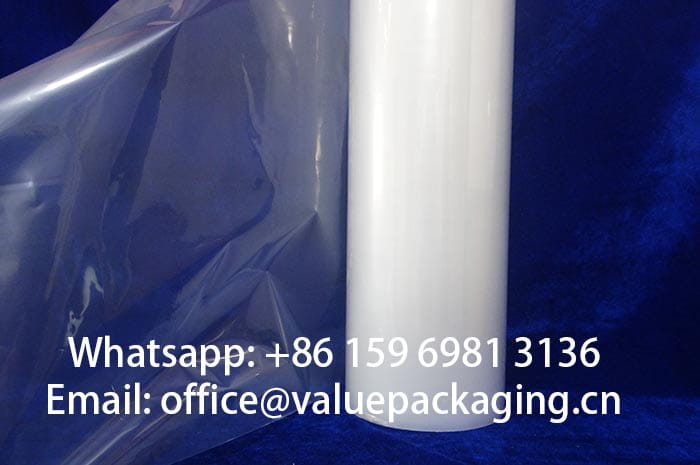
The property of the LDPE film should be modified to resist the alkaline corrosion of the liquid detergent. Different formulas of detergent liquids may require a particular modification of the low-density polyethylene film.
The customer artwork is printed reversely on the inner side of the first PET film layer in the gravure printing system. These 3 layers are bonded together into a finished laminated foil material under the dry lamination or solvent-free lamination process. Usually, we describe the finished laminate as PET/BOPA/LDPE foil.
Thickness
As you can see from the below picture, the overall thickness of this spout pouch is 0.42 mm, which equals to 210 microns for this laminated foil.
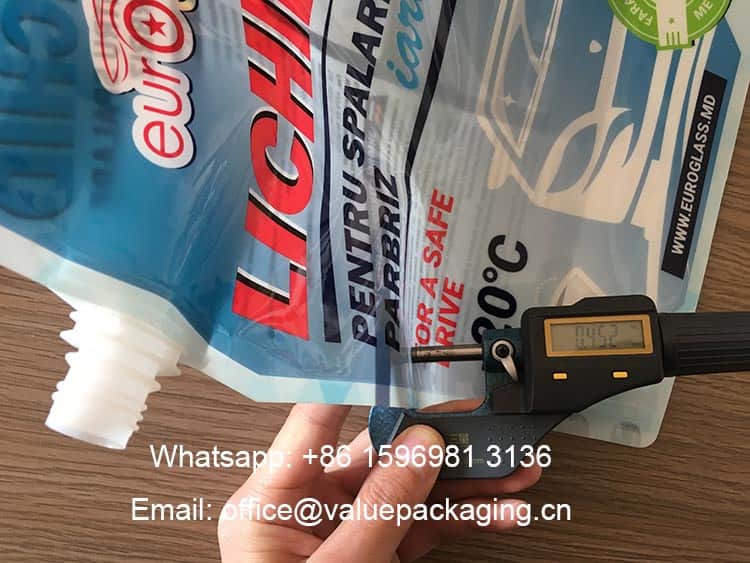
So, how does this foil structure perform when it is intended for standup cleaning liquids bags? Will it break during the transit?
Great Standup Effect
Through the below video, you may learn the standing effect when 2 liters of liquid chemicals is filled into spout bag based on this laminated foil PET12/PA15/LDPE180.
Mechanical Property
The spout package will protect the 2 litre household cleaning liquids product during filling, transit, and distribution. Under the emergency circumstances of unexpected shock in delivery or packages falling off the goods shelf, the spout package will never be allowed to break. Can you ever imagine the leaked household cleaning liquids contaminating the cartons or the floor?
We put the mechanical property of this 2000ml cleaning liquids standup doypack on our top priority in our manufacturing plant. Serious measures are taken in our QC system, to assure each order is finalized with the expected result.
To put it simply, a drop test of a filled package is one of the most reliable ways to check if the package may burst under sudden sharp forces.
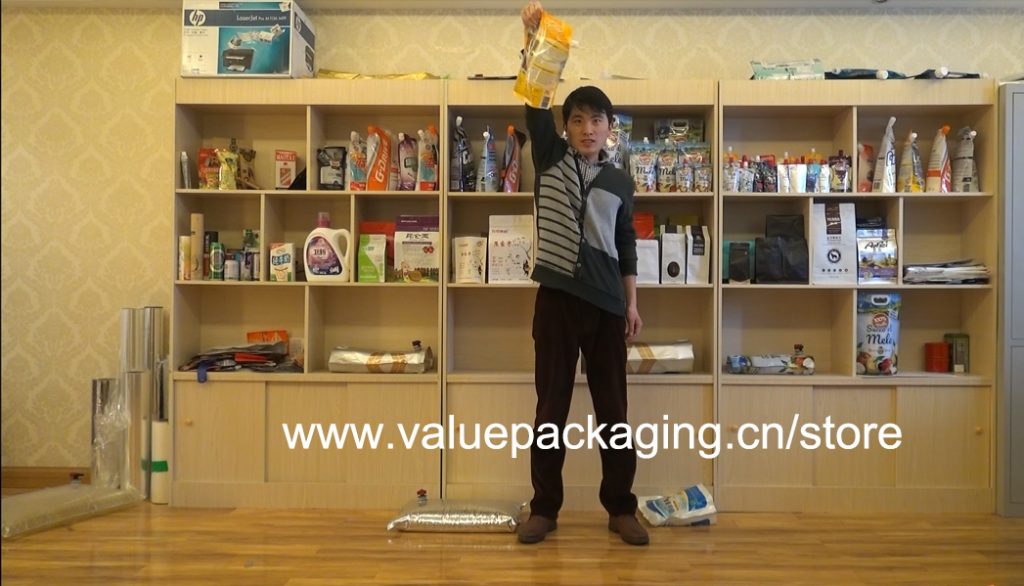
Here, we are going to fill 2000ml water into this bag, perform the drop test from 1.6 meters high, 3 times, and check if it breaks.
This foil laminate can be good for cleaning liquid packs of 1litre, 2 litre, 3 litres and even 1 gallon. Of course, there are reinforced foil structures available for more robust packages.
- PET12/PA25/LDPE
- PA15/PA15/LDPE
- PA15/PA25/LDPE
Barrier Performance
Generally, The essential formulas of a household cleaning liquid should include but not be limited to the list below.
- primary and secondary surfactants
- chelating agents
- enzymes
- builders
- bleaching agents
- optical brighteners
- foam control agents
- fragrances
- colorants
- preservatives
Upon our experience, all the bags for household cleaning liquids should be light-shielding to protect the formulas work as expected. Because strong light will decrease the cleaning effects, and some fragrances may decompose or deteriorate. Cleaning liquids products will be kept away from the light shielding to stay function-active as long as possible.
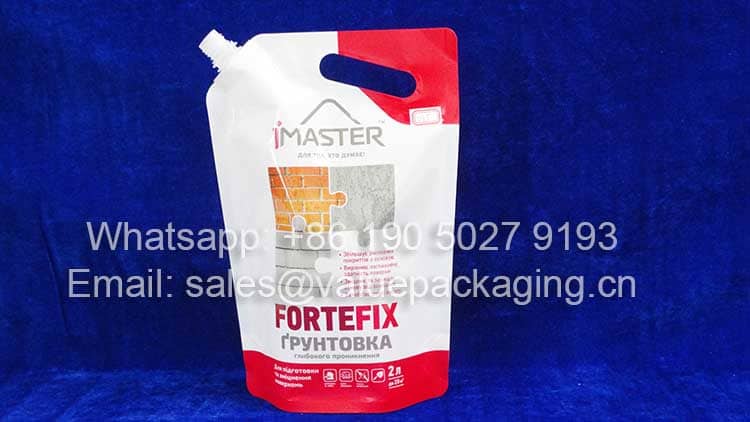
As you can observe from the above picture, the bag is semi-transparent and the filled level can be easily seen at the lower part of the bottom.
WVTR (short for water vapor transmission rate) and OTR (Oxygen Transmission Rate) are evaluated for this laminated foil, to decide if this spout doypack is finally meeting the requirements of each customer.
| Item | Standard | Unit | Typical Value |
| Water Vapor Transimission Rate | ASTM E 96 | g/m2/24hr | 19.5 |
| Oxygen Transmission Rate | ASTM D 372-99 | cc/m2/24hr | 8.5 |
Technical Data Sheet of 2 litre spout pouch for household cleaning
Here, we attach the specification sheet of this 2000ml liquids sahcet based on foil laminate PET12/PA15/LDPE180.
More tests are included in this specification sheet with items available listed as below.
- Yield (grams per square meter)
- Tensile Strength (Mpa)
- Elongation Rate (%)
- Coefficient of friction, short as COF
- Solvents Left (mg/m2 )
- Sealing Strength (N/15mm)
- Sealing Conditions
- Bond Strength (N/15mm)
- Burst Strength (J)
- Anti-Puncture ability (N)
- Drop Test Ability (cm)
- Anti-pressure ability (kgs)
- Water Vapor Transmission Rate (g/m2/24hr)
- Oxygen Transmission Rate (cc/m2/24hr)
If you want to get a further understanding of this PET/PA/LDPE laminated foil, you may just read it here.
More Sustainable Materials Options
Along with the increasing burden of fossil-chemical polymer materials discarded into our environment, there is an unprecedented demand for sustainable packages which leads to a more eco-friendly activity of the business. Upon the recent investigation of the detergent market, more and more consumers are more likely to purchase a product that acts toward environmental sustainability.
Compostable Packaging Materials
Some of our customers are trying to replace their traditional film materials with compostable items. You can see the roll in below picture is actually made of 100% compostable materials, for one of our customers in New Zealand.
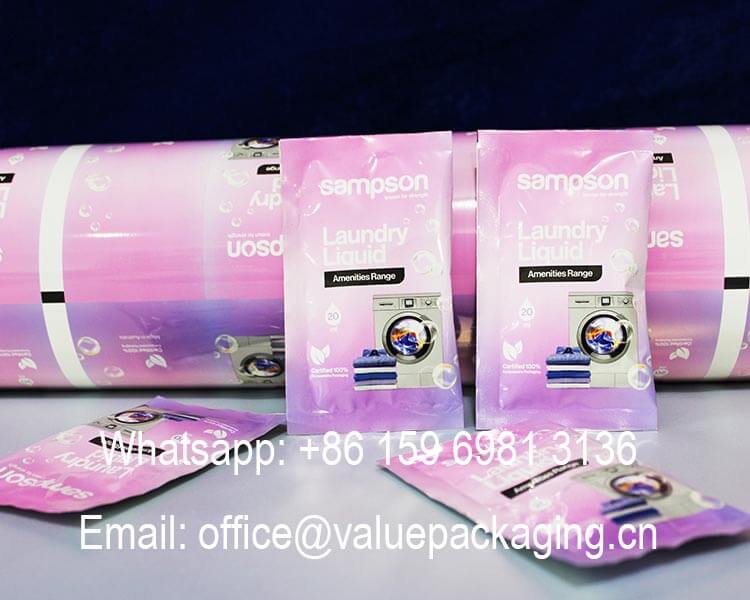
The below graphic shows clearly the foil structure for this laminated compostable foil.

The artwork is printed reversely on the inner side of plant-based cellulose film, with another layer of metallized cellulose working as the light-shielding and barrier layer, and PLA+PBAT biodegradable film works as the inner sealing layer.
However, it didn’t hit the customer’s expect.
As explained previously, it is crucial for the laminated foil to protect the formulas of the liquid cleaning in the sachet. However, for this compostable foil, the ingredients of the liquid detergent can easily penetrate into the PLA+PBAT film, which is in full touch with the liquids for all the time. When a certain amount of ingredients passes through the PLA+PBAT film, it will inevitably damage the adhesive between PLA+PBAT film and metallized cellulose, which leads to the delamination of this foil.
For this customer, the compostable foil fails to meet his requirements.
Based on this situation, the compostable foil materials will never be allowed to hold products in large volumes, like 1 litre, 2 liters, or 3 liters. That is different from the traditional polymer film materials explained above. You may us for further ideas if you need.
Fully Recyclable Mono Materials
Limited to the current development of the mono film materials, the mechanical strength of the finished foil laminate can not be strong enough for 2 liters of capacity. In most cases, the fully recyclable spout pouch can only be able to hold 300 ml of cleaning liquids.
Now it’s the end. You are welcome to reach us when you have any questions regarding the pouches. Have a nice day.

